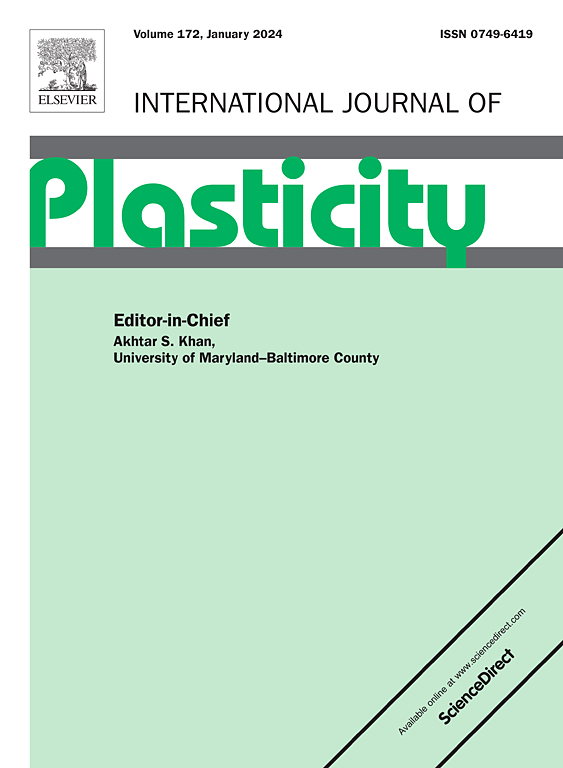Lowering creep rate in Mg-Zn-Ca magnesium alloy with hierarchical distribution of phases
IF 9.4
1区 材料科学
Q1 ENGINEERING, MECHANICAL
引用次数: 0
Abstract
The improvement of creep resistance remains an important challenge for engineering applications of magnesium (Mg) alloys at elevated temperatures. Based on the experimental investigations and crystal plastic finite element method (CPFEM), the creep deformation mechanisms of the AC3 (Mg-5Al-3Ca) and ZC1 (Mg-5Zn-1Ca) alloys (both in wt.%) were proposed separately in this study. The results indicate that the ZC1 alloy with lower content of Ca and hierarchical distribution of strengthening phases exhibits superior creep resistance compared to the AC3 alloy. This superiority of ZC1 alloy is attributed to the low mechanical incompatibility between the skeleton Ca2Mg6Zn3 phases and the α-Mg matrix, as well as the presence of small dispersed particles in the grain interior surrounded by stable skeleton phases. The interconnectedness of the skeleton intermetallic phase affects the creep resistance of Mg alloys. During the creep process of the AC3 alloy, local stress concentration led to the cracking of the hard skeleton Al2Ca phase, grain boundaries (GBs) sliding, and grain coarsening/rotating, resulting in large creep rate. In the ZC1 alloy, the skeleton Ca2Mg6Zn3 phases distributed along the GBs act as barriers to GB sliding. In addition, the particle precipitates inside the grains which have an orientation relationship with the α-Mg matrix can additionally strengthen the matrix, effectively preventing the motion of basal 〈a〉 dislocations. The findings of this study provide a strategy to design high creep-resistant Mg alloys by synergistic effect of the stable skeleton phase and dispersed particle phase.


降低相分层分布Mg-Zn-Ca镁合金的蠕变速率
提高镁合金在高温下的抗蠕变性能是镁合金工程应用面临的一个重要挑战。基于实验研究和晶体塑性有限元方法,分别提出了AC3 (Mg-5Al-3Ca)和ZC1 (Mg-5Zn-1Ca)合金(wt.%)的蠕变变形机理。结果表明,与AC3合金相比,Ca含量较低且强化相分层分布的ZC1合金具有更好的抗蠕变性能。ZC1合金的这一优势是由于骨架Ca2Mg6Zn3相与α-Mg基体的力学不相容程度低,以及在稳定骨架相包围的晶粒内部存在分散的小颗粒。骨架金属间相的连通性影响着镁合金的抗蠕变性能。AC3合金在蠕变过程中,局部应力集中导致硬骨架Al2Ca相开裂,晶界(GBs)滑动,晶粒粗化/旋转,蠕变速率较大。在ZC1合金中,沿晶界分布的骨架Ca2Mg6Zn3相是晶界滑动的障碍。此外,晶粒内部与α-Mg基体有取向关系的颗粒析出物能进一步强化基体,有效地阻止基体的运动;混乱。本研究结果为利用稳定骨架相和分散颗粒相的协同作用设计高抗蠕变镁合金提供了思路。
本文章由计算机程序翻译,如有差异,请以英文原文为准。
求助全文
约1分钟内获得全文
求助全文
来源期刊

International Journal of Plasticity
工程技术-材料科学:综合
CiteScore
15.30
自引率
26.50%
发文量
256
审稿时长
46 days
期刊介绍:
International Journal of Plasticity aims to present original research encompassing all facets of plastic deformation, damage, and fracture behavior in both isotropic and anisotropic solids. This includes exploring the thermodynamics of plasticity and fracture, continuum theory, and macroscopic as well as microscopic phenomena.
Topics of interest span the plastic behavior of single crystals and polycrystalline metals, ceramics, rocks, soils, composites, nanocrystalline and microelectronics materials, shape memory alloys, ferroelectric ceramics, thin films, and polymers. Additionally, the journal covers plasticity aspects of failure and fracture mechanics. Contributions involving significant experimental, numerical, or theoretical advancements that enhance the understanding of the plastic behavior of solids are particularly valued. Papers addressing the modeling of finite nonlinear elastic deformation, bearing similarities to the modeling of plastic deformation, are also welcomed.
 求助内容:
求助内容: 应助结果提醒方式:
应助结果提醒方式:


